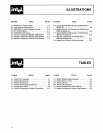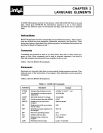
Introduction to BASIC-80
1-2
To
invoke BASIC-80 from ISIS-II, enter the name
of
the file that contains the
BASIC interpreter. Options also allow you to specify the name
of
a file that contains
a program to be loaded after
BASIC-80
is
running, and upper memory limit for
BASIC-80's work area. The format
of
the command is:
-BASIC
[filename] [MEMTOP(address)]
is
the ISIS-II command prompt.
It
is
displayed automatically before you
enter the command.
BASIC
specifies the name
of
the file that contains the
BASIC-SO
interpreter.
filename
is
an optional parameter
that
specifies the name
of
a file that
is
to be
loaded and run after
BASIC-SO
is
running.
MEMTOP(address)
is
an
optional parameter that specifies the upper bound
of
the memory
that
BASIC-80 can use. Address can be either a decimal
or
hexadecimal
number.
It
must be greater
than
3800H plus the number
of
bytes in the
interpreter, and less
than
OBEBFH in a
48K
system
or
OF6BFH in a
64K
system.
Examples
1.
If
the interpreter
is
in a file named BASIC
on
a disk in drive 0 enter:
-BASIC
2.
If
the situation
is
the same as
1,
but
you want to run a file named ANLYZE on
a disk in drive
1:
-BASIC
:F1
:ANL YZE
3.
If
the
situation
is
the same as 2,
but
you also want to prevent BASIC-80 from
using memory beyond address
54400:
-BASIC
:F1
:ANLYZE MEMTOP(54400)
If
a fatal ISIS-II error occurs while BASIC-80
is
running, ISIS-II
is
re-
initialized and the contents
of
the BASIC-80 work area
is
lost, including any
program editing you have done since you last entered a save command.
Manipulating Files from BASIC-SO
BASIC-80 lets you list a disk directory, rename a file, change the attributes of a file,
and delete a file. These functions can also be performed using
ISIS-II
or
RMX-80,
of course.
BAS
IC-80


















